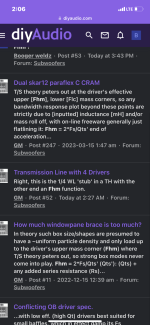Once damped, nothing IME, just the inverse tapered TQWT can be made smaller due to less damping required when 'critically' damped.
Oh this is good! Thanks GregCorrect and I'd DIYed Jensen's Transflex, a '50s TTL back in the '60s plus freddyi was aware of it and found/aware of? a TH variant patent, so we wasted no time 'challenging' Tom's.
Sim individual driver positions and contemplate the response shape that would result from somehow combining them or ?That Bose (supposedly) TL is nothin more than a TH or BP6S.
I thought TL are nothing more than flared port BR's.
This...
View attachment 1158473
is the same thing as this...
View attachment 1158474
The Bose enclosure just has more drivers.
That Bose (supposedly) TL is nothin more than a TH or BP6S.
I thought TL are nothing more than flared port BR's.
This...
View attachment 1158473
is the same thing as this...
View attachment 1158474
The Bose enclosure just has more drivers.
i always found this interesting, and then wondered what the combined result(not the individual variety of simmed positions) would acually be ?
Probably not the right terminology on my part, just basic conceptA 0.5 alignment may yet be the way I go.
of dedicating drivers to a certain bandwidth like many other speaker designs
The question was how to fit 4x drivers in a TL
The approach is 2x drivers in the line. dedicated to a certain bandwidth.
like any other design which makes up for loses to full space in the bass region.
2 way design in other words, crossover for bass
Most bass amps have EQ and that has been the solution to full space loses.
A player just adds boost or gooses the low end.
So a more " efficient" design actually has same loses if not more.
Max SPL is reduced from boosting bass. Distortion is reached faster.
likewise the " wide bandwidth" speakers potential is EQ'ed out.
Ever so classic...Mid cut, bass boost.
Instead of cutting what it is good at and boosting what it cant do.
The design changes, more drivers dedicated to bass or fullspace loses
less drivers to higher bandwith. In the end same SPL
Traditional EQ not the fix anymore.
in the end less distortion, less dominance from EQ to fix the classic
stage amp scenario. no need to cut what it can do, and boost what it
can not do. On paper a more " efficient" system isn't from the traditional
approach.
You didn't mix the variations...LOL!Sim individual driver positions and contemplate the response shape that would result from somehow combining them or ?
View attachment 1158554
View attachment 1158556
View attachment 1158557
View attachment 1158558
View attachment 1158559
View attachment 1158560
View attachment 1158561
i always found this interesting, and then wondered what the combined result(not the individual variety of simmed positions) would acually be ?
L12 = 10cm.
L23 = 90cm.
L34 = 80cm.
L45 = 20cm.
Or
L12 = 60cm.
L23 = 40cm.
L34 = 70cm.
L45 = 30cm.
Either way good reminder,
How glorious and fascinating transmission lines are to design.
The intriguing rabbit hole.
Then again good visual reminder of the roller coaster
frequency response and roller coaster impedance curve.
When you start to model live audio drivers.
4x10 in 200 liters
2x15 in 200 liters
1x18 in 200 liters
= same thing.
How glorious and fascinating transmission lines are to design.
The intriguing rabbit hole.
Then again good visual reminder of the roller coaster
frequency response and roller coaster impedance curve.
When you start to model live audio drivers.
4x10 in 200 liters
2x15 in 200 liters
1x18 in 200 liters
= same thing.
So what causes the saggy middle in the above sims ? tHe lack of a resonance in the system, except at the ends of the BW…. but the closer drivers together then the ‘more’ the cancel that sound increasingly (if that makes sense?) ?
I dunno how to explain it 🙈
I dunno how to explain it 🙈
Moving the driver entry point in 'throat end' only all the way up to ’fixing’ the 3/4 harmonic in the last pic @ about 1/3-2/3.
What exactly does that offset driver entry do?
😝
What exactly does that offset driver entry do? Is it a quarter Wave length of the freq it’s stopping from resonating ? Or is it creating an upstream helmholtz resonator?
😝
What exactly does that offset driver entry do? Is it a quarter Wave length of the freq it’s stopping from resonating ? Or is it creating an upstream helmholtz resonator?
stretching the distance from exit instead of entry and exit
Right, this is the 1/4 WL 'stub' in a TH with the other end an Fhm function.
I often dont know many of your abbreviations.
or the full length version 😝. But this isnt too bad, thanks for the hint ?
https://fhm.com/
or the full length version 😝. But this isnt too bad, thanks for the hint ?
https://fhm.com/
Last edited:
No:
upper: Fhm = 2*Fs/Qts'
lower: Flc = Fs*Qts'/2 (AFAIK only used for reactance annulled BLHs)
Qts': 2*Fs/Fhm
Maybe more easily understood from a horn loading POV along with all the extra math (pg. 7):
http://www.xlrtechs.com/dbkeele.com/PDF/Keele (1977-05 AES Preprint) - LF Horn Design Using TS Paras.pdf
(Qts'): (Qts) + any added series resistance (Rs): http://www.mh-audio.nl/Calculators/newqts.html
upper: Fhm = 2*Fs/Qts'
lower: Flc = Fs*Qts'/2 (AFAIK only used for reactance annulled BLHs)
Qts': 2*Fs/Fhm
Maybe more easily understood from a horn loading POV along with all the extra math (pg. 7):
http://www.xlrtechs.com/dbkeele.com/PDF/Keele (1977-05 AES Preprint) - LF Horn Design Using TS Paras.pdf
(Qts'): (Qts) + any added series resistance (Rs): http://www.mh-audio.nl/Calculators/newqts.html
- Home
- Loudspeakers
- Subwoofers
- Transmission Line with 4 Drivers
